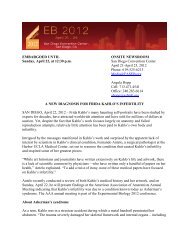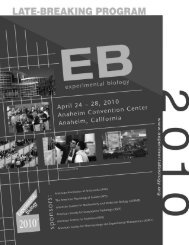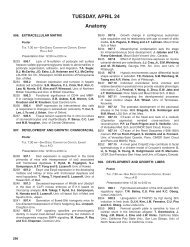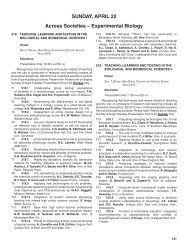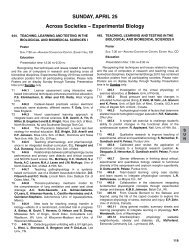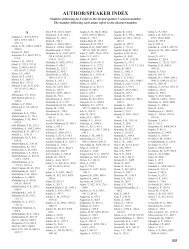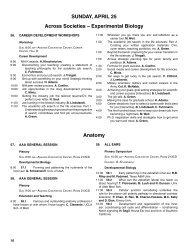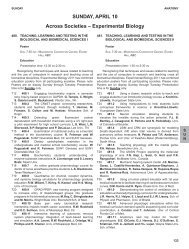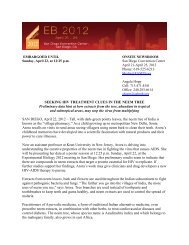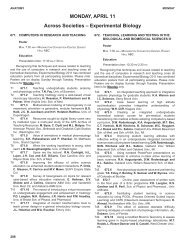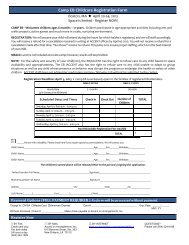Tuesday, april 27 anatomy - Experimental Biology
Tuesday, april 27 anatomy - Experimental Biology
Tuesday, april 27 anatomy - Experimental Biology
- No tags were found...
Create successful ePaper yourself
Turn your PDF publications into a flip-book with our unique Google optimized e-Paper software.
tuesday<br />
1026. Control of Breathing: Chemoreception<br />
Poster<br />
Tu e. 7:30 a m—An a h e i m Co n v e n t i o n Ce n t e r, Ex h i b it Ha l l CD<br />
Presentation time: 12:45 p m-3:00 p m<br />
D669 1026.1 Role of pH regulatory components in the<br />
transduction response of central CO 2<br />
chemoreceptors. J.M.<br />
Cordovez, C. Clausen, L.C. Moore and I.C. Solomon. Stony<br />
Brook Univ. and Univ. of los Andes, Colombia.<br />
D670 1026.2 Connexin 26 is responsible for ATP release<br />
underlying central CO 2<br />
chemosensitivity. R.T.R. Huckstepp,<br />
R.C. Eason, R. id Bihi, N. Dicke, K. Willecke, K.M. Spyer,<br />
A.V. Gourine and N. Dale. Warwick Univ., U.K., Univ. of Bonn<br />
and University Col. London.<br />
D671 1026.3 The bullfrog neuroventilatory response to<br />
hypercapnia is unaffected by cannabinergic potentiation. N.B.<br />
Bajada, C.M. Brundage and B.E. Taylor. Univ. of Alaska<br />
Fairbanks.<br />
D672 1026.4 Leptin deficiency impairs hypercapnic<br />
ventilatory responses independently of changes in body weight.<br />
M. Bassi, J.M. do Carmo, S. Hamza and J.E. Hall. Univ. of<br />
Mississippi Med. Ctr.<br />
D673 1026.5 Modulation of neuroventilation and central<br />
chemosensitivity: serotonergic and hypocretinergic effects.<br />
A.E. Corcoran, G.B. Richerson and M.B. Harris. Dartmouth<br />
Med. Sch., Yale Univ. and Univ. of Alaska Fairbanks.<br />
D674 1026.6 Chronic administration of fluoxetine markedly<br />
attenuates the hypercapnic ventilatory response in urethaneanesthetized<br />
female mice. T.A. Bale and I.C. Solomon. Stony<br />
Brook Univ.<br />
D675 1026.7 Raphe serotonin neurons: characteristics of<br />
central chemoreceptors in situ. K.E. Iceman, A.E. Corcoran<br />
and M.B. Harris. Univ. of Alaska Fairbanks and Dartmouth<br />
Med. Sch.<br />
D676 1026.8 The orexin receptor 1 in the rostral medullary<br />
raphe contributes to the hypercapnic chemoreflex in<br />
wakefulness, during the dark (active) period of the diurnal<br />
cycle. M.B. Dias, A. Li and E.E. Nattie. Dartmouth Med. Sch.<br />
D677 1026.9 Effects of bilateral inhibition of retrotrapezoid<br />
nucleus on breathing in conscious rats. A.C. Takakura, T.S.<br />
Moreira, P.M. De Paula, J.V. Menani and E. Colombari. São<br />
Paulo State Univ., Araraquara, Univ. of São Paulo and Fed.<br />
Univ. of São Paulo.<br />
D678 1026.10 Photostimulation of channelrhodopsintransfected<br />
rostral medullary Phox2b-expressing neurons<br />
activates breathing in unaesthetized rats. R. Kanbar, R.L.<br />
Stornetta, S.J. Lewis and P.G. Guyenet. Univ. of Virginia.<br />
D679 1026.11 Changes on respiratory chemosensitivity after<br />
vagotomy in rats. T.S. Moreira and A.C. Takakura. Univ. of São<br />
Paulo and São Paulo State Univ., Araraquara.<br />
D680 1026.12 Focal acidification of the caudal ventrolateral<br />
medulla (Loeschcke’s area) increases ventilation during<br />
wakefulness but not in sleep. G.S.F. Silva, A. Li and E. Nattie.<br />
Dartmouth Med. Sch.<br />
D681<br />
1026.13 NK-1 receptors expressing neurons in the locus<br />
coeruleus play a role in cardiorespiratory response to CO 2<br />
. L.H.<br />
Gargaglioni, D. de Carvalho, K.C. Bicego, G.S. Ferreira da<br />
Silva, O.W. Castro and N. Garcia-Cairasco. FCAVJ-São Paulo<br />
State Univ. and FMRP-Univ. of São Paulo, Ribeirão Preto.<br />
pHysiology<br />
D682 1026.14 Further evidence of redox modulation of<br />
neurons in a CO 2<br />
-chemosensitive area: normobaric hyperoxia<br />
(95%O 2<br />
) stimulates CO 2<br />
-chemosensitive and –insensitive<br />
neurons in the solitary comple. M.P. Matott, C.S. Landon,<br />
R.W. Putnam and J.B. Dean. Univ. of South Florida and Wright<br />
State Univ.<br />
D683 1026.15 The effect of hypoxia on the ventilatory and<br />
cerebral blood flow responses to CO 2<br />
. A. Battisti, J. Fisher<br />
and J. Duffin. Univ. of Toronto and Toronto Gen. Hosp.<br />
D684 1026.16 Oxygen transport from air to cell: the impact of<br />
age. M. Amann, D.W. Wray, C. Wary, A. Monnet, P.G. Carlier<br />
and R.S. Richardson. Univ. of Utah, Pitié-Salpêtrière Univ.<br />
Hosp., Paris and VA Med. Ctr., Salt Lake City.<br />
D685 1026.17 Baroreflex unloading blunts chemoreceptor<br />
sensitivity in postural tachycardia syndrome. I. Taneja, D.A.<br />
Clarke, M.S. Medow, A.J. Ocon and J.M. Stewart. New York<br />
Med. Col.<br />
D686 1026.18 Prolonged maintenance of cardiopulmonary<br />
stability in mice: strain-specific ventilatory requirements. L.<br />
Pichard, E. Kostuk, P. Pashai, R. Fitzgerald and M. Shirahata.<br />
Johns Hopkins Univ.<br />
D687 1026.19 Murine carotid body responses to hypoxia:<br />
in vivo carotid sinus nerve recordings in the DBA/2J and A/J<br />
strains. L. Pichard, F. Sgambati, E. Kostuk, P. Bashai, R.<br />
Fitzgerald and M. Shirahata. Johns Hopkins Univ.<br />
D688 1026.20 Global knockout of AMP-activated protein<br />
kinase alpha subunits attenuates the hypoxic ventilatory<br />
response in mice. C.N. Wyatt, H.L. Jordan, B.L. Barr, B.<br />
Viollet, C. Peers, D.G. Hardie and A.M. Evans. Wright State<br />
Univ., INSERM, Paris, Leeds Univ., Univ. of Dundee and Univ.<br />
of Edinburgh.<br />
D689 1026.21 In vivo pharmacological alterations of murine<br />
carotid body responses to hypoxia: the role of BK channels<br />
in hypoxic sensitivity. L. Pichard, F. Sgambati, E. Kostuk,<br />
P. Bashai, R. Fitzgerald and M. Shirahata. Johns Hopkins<br />
Univ.<br />
D690 1026.22 Hypoxia versus hydrogen sulfide acting at the<br />
carotid body and elsewhere systemically. R.S. Fitzgerald, M.<br />
Shirahata and E. Kostuk. Johns Hopkins Univ.<br />
D691 1026.23 Effects of HIF-1a gene deletion in respiratory<br />
centers on ventilatory acclimatization to hypoxia. A. Go, Z. Fu,<br />
R.S. Johnson and F.L. Powell. UCSD.<br />
D692 1026.24 The effect of chronic ibuprofen treatment on<br />
ventilatory acclimatization to hypoxia. D. Popa, Z. Fu and F.<br />
Powell. UCSD.<br />
D693 1026.25 Chronic sustained hypoxia reduces neuronal<br />
excitability in 2nd-order neurons of peripheral chemoreceptors<br />
in the NTS. W. Zhang and S. Mifflin. Univ. of North Texas Hlth.<br />
Sci. Ctr. at Fort Worth.<br />
D694 1026.26 Activation of adenosine A2A receptor<br />
on GABAergic inputs to 2nd-order neurons of peripheral<br />
chemoreceptors in the NTS. W. Zhang and S.W. Mifflin. Univ.<br />
of North Texas Hlth. Sci. Ctr. at Fort Worth.<br />
D695 1026.<strong>27</strong> Developmental regulation of glucosensing in<br />
rat adrenomedullary chromaffin cells. S.J. Livermore, N.A.<br />
Piskuric, J.A. Buttigieg and C.A. Nurse. McMaster Univ.,<br />
Canada and Toronto Western Hosp.<br />
D696 1026.28 Intermittent hypoxia enhances chemical<br />
sensitivity of pulmonary C fibers in rats: role of reactive oxygen<br />
species. M-Y. Shen, Y-L. Luo and C.J. Lai. Tzu Chi Univ.,<br />
Taiwan.<br />
t<br />
u<br />
e<br />
323



